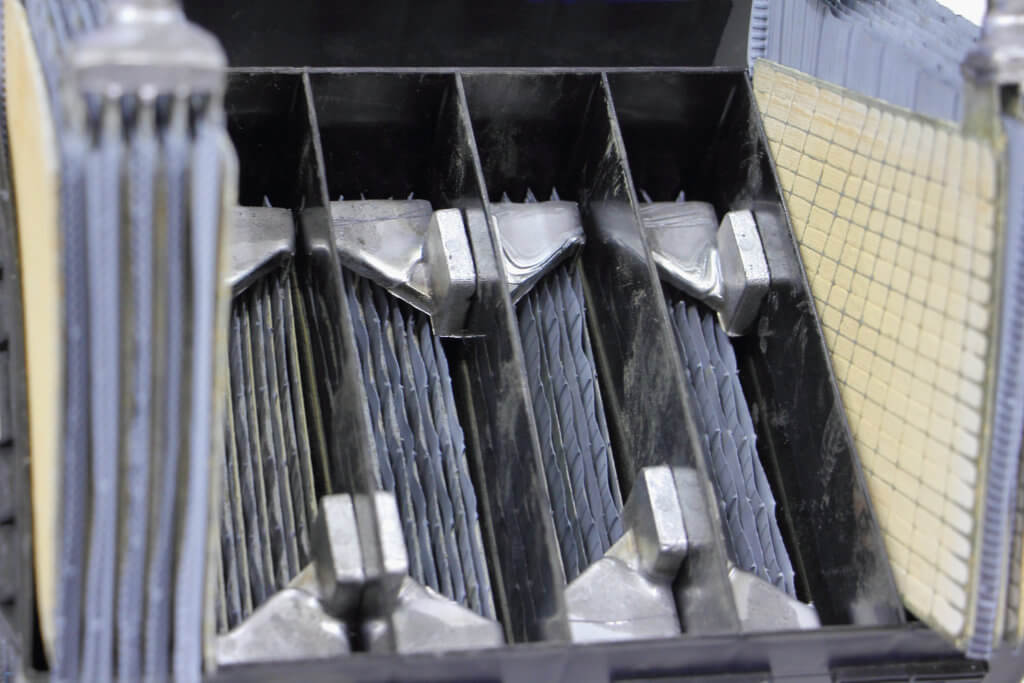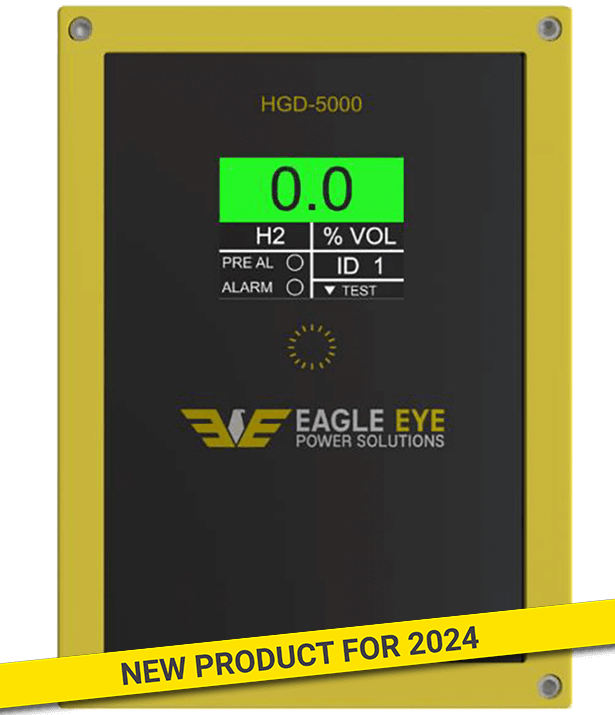The term “Sealed Maintenance-Free,” in my opinion, is a marketing-driven term. In the early 1980’s, when telephone Private Branch Exchanges (PBX’s) were being deployed into customer premises, computer mainframes were migrating out of dedicated computer rooms, and smaller computers were being situated in occupied office space. Consequently, users were demanding that the battery manufacturers come up with backup batteries that were smaller, lighter, more user-friendly, and could safely be used co-located with electronic equipment outside of a dedicated battery room. Well, the manufacturers and their marketing arms came up with what the users wanted, and they touted them as “Sealed Maintenance-Free Batteries.” However, nothing could be further from the truth.
There were basically two types of so-called “sealed maintenance-free” stationary batteries:
- Absorbed Glass Mat (AGM) batteries, where the liquid electrolyte is absorbed in the sponge-like glass mat plate separators
- Gelled electrolyte type, generally called “Gel Cells,” where the liquid electrolyte is gelled by adding a gelling agent.
However, in both cases, in order to enable the oxygen and hydrogen recombination process internally, the cells/units are sealed under normal operating conditions but the battery cells/units require a pressure relief valve in order to vent gasses in the event of over pressurization within the cell/unit. Hence, VRLA batteries are not sealed. And as to being maintenance free? Think again.
A Brief History of VRLA Batteries
The idea of an immobilized electrolyte battery goes back to 1934 when it was first investigated by a German company. he first gelled Valve-Regulated Lead-Acid (VRLA) battery was invented by Otto Jache of the German Company Sonnenschein in 1957. The first Absorbed Glass Mat (AGM) battery was developed and patented by the Gates Rubber Company in America. In 1965, a 40-year-old electrical engineer, John Devitt, sent a nine-page memo entitled “Lead-Acid Sealed Cells” to the head of research at Gates. What followed was to revolutionize the battery industry and the commercialized VRLA battery was born. I guess we could blame John for first using the term “sealed” but I don’t think that he meant it in the true sense. In 2003, I had the distinct pleasure of presenting John with the first Battcon Hall-of-Fame Award,
The Gates battery was a spiral wound battery with lead foil electrodes, but several manufacturers used this basic technology and came up with battery cells that had flat plates, similar to the conventional Vented Lead-Acid (VLA) batteries. In the early 1980’s (and I remember it well) two British companies, Tungstone and Chloride, came up with a supposedly ten-year-life AGM battery in order to satisfy a British Telecom requirement for their new digital telecom exchange. GNB was to lead the charge in the USA and eventually came up with larger capacity and supposedly longer-life VRLA batteries. Today, almost all lead-acid battery manufacturers have a VRLA battery line.
Enter the Institute of Electrical and Electronics Engineers (IEEE)
In the 1980’s, stationary VRLA batteries were a whole new ball game to the IEEE Power and Energy Society’s Stationary Battery Committee (IEEE PES SBC), as it was called at the time, now known as the IEEE Energy Storage and Stationary Battery (ESSB) Committee. In fact, the whole VRLA battery issue was the very reason that prompted me to join the IEEE stationary battery committees. I was working for a company that was installing thousands of VRLA batteries which were failing all over the place. The problems were not only being caused by the manufactures but also by misapplication and misuse. So the IEEE started developing VRLA battery standards, guides and practices. These were IEEE Standards 1187, 1188 and 1189, which dealt with the installation, maintenance and selection of VRLA batteries. Problems with VRLA batteries were also a catalyst to the foundation of Battcon, the international stationary battery conference. Please see the Eagle Eye May 2020 newsletter for further information regarding the history of Battcon.
The introduction of a newly developed IEEE Std 1188-1996 IEEE Recommended Practice for Maintenance, Testing, and Replacement of Valve-Regulated Lead-Acid (VRLA) Batteries for Stationary Applications states that: “Stationary lead-acid batteries play an ever increasing role in industry today by providing backup power for a wide range of applications. IEEE Std 450-1995 has provided the users with standard practices for battery maintenance, testing, and replacement for vented batteries. With the introduction of the valve-regulated lead-acid (VRLA) battery several years ago, there are unique characteristics that are not covered by the existing documents. This recommended practice fulfills the need within the industry to provide common or standard practices for battery maintenance, testing, and replacement of VRLA batteries for stationary applications. This recommended practice may be used separately, and when combined with IEEE Std 1187-1996, IEEE Std 1189-1996, and IEEE Std 485-1983, will provide the user with a general guide to selection, sizing, designing, installing, and testing a VRLA battery installation.”
Because the containers of Vented Lead-Acid (VLA) batteries are clear, a lot can be learned about the condition of the battery by visual inspection. However, since the containers of VRLA batteries are opaque, internal visual inspection is not possible. But are VRLA batteries maintenance free? Definitely not, according to common sense and the IEEE. In section 5 of IEEE Std 1188 – 2005, it calls for ten monthly inspection and test measurements, thirteen quarterly items, and fifteen yearly actions. Admittedly, some of these items refer to associated equipment, such as chargers and ambient conditions, but most are directly related to the battery itself.
Fallout from Misuse of the Terms “Maintenance Free” and “Sealed”
Unfortunately, when users believe that their batteries do not require maintenance, consequently they ignore any maintenance activity. I have evidenced failed VRLA batteries that have never been maintained. I also heard numerous times when users are being solicited regarding purchasing a maintenance contract, they respond that they don’t need one because they have maintenance-free batteries.
As to VRLA batteries being sealed, well IEEE Std 1635-2012/ASHRAE Guideline 21-2012, IEEE/ASHRAE Guide for the Ventilation and Thermal Management of Batteries for Stationary Applications contains section 5.1.1.2, titled, Valve-regulated lead-acid (VRLA) batteries. It specifically deals with gassing of VRLA batteries that are supposedly sealed! It states, in part: “The pressure relief valve allows excess internal pressure from generated gases to be relieved while preventing atmospheric air from entering the battery. When the valves do function to relieve internal pressure, the gases that escape directly equate to a loss of water from the battery that generally cannot be replaced.” This fact is probably where the term, “maintenance-free” was first conjured up, i.e. the fact that water did not need to be replenished into the electrolyte as was the case with traditional VLA batteries. Outgassing of VRLA batteries usually occurs when the charge current increases to a point where the oxygen generation rate exceeds the diffusion rate at the negative plate, and oxygen and hydrogen will be vented through the pressure relief valve.
Myth Debunked?
So, in summary, the so called “sealed maintenance-free” batteries are neither sealed nor maintenance free, so why perpetuate the myth? When I looked up the Wikipedia definition of VRLA batteries, the first sentence was: “A valve regulated lead–acid (VRLA) battery, commonly known as a sealed lead–acid (SLA) battery …” Go figure!


